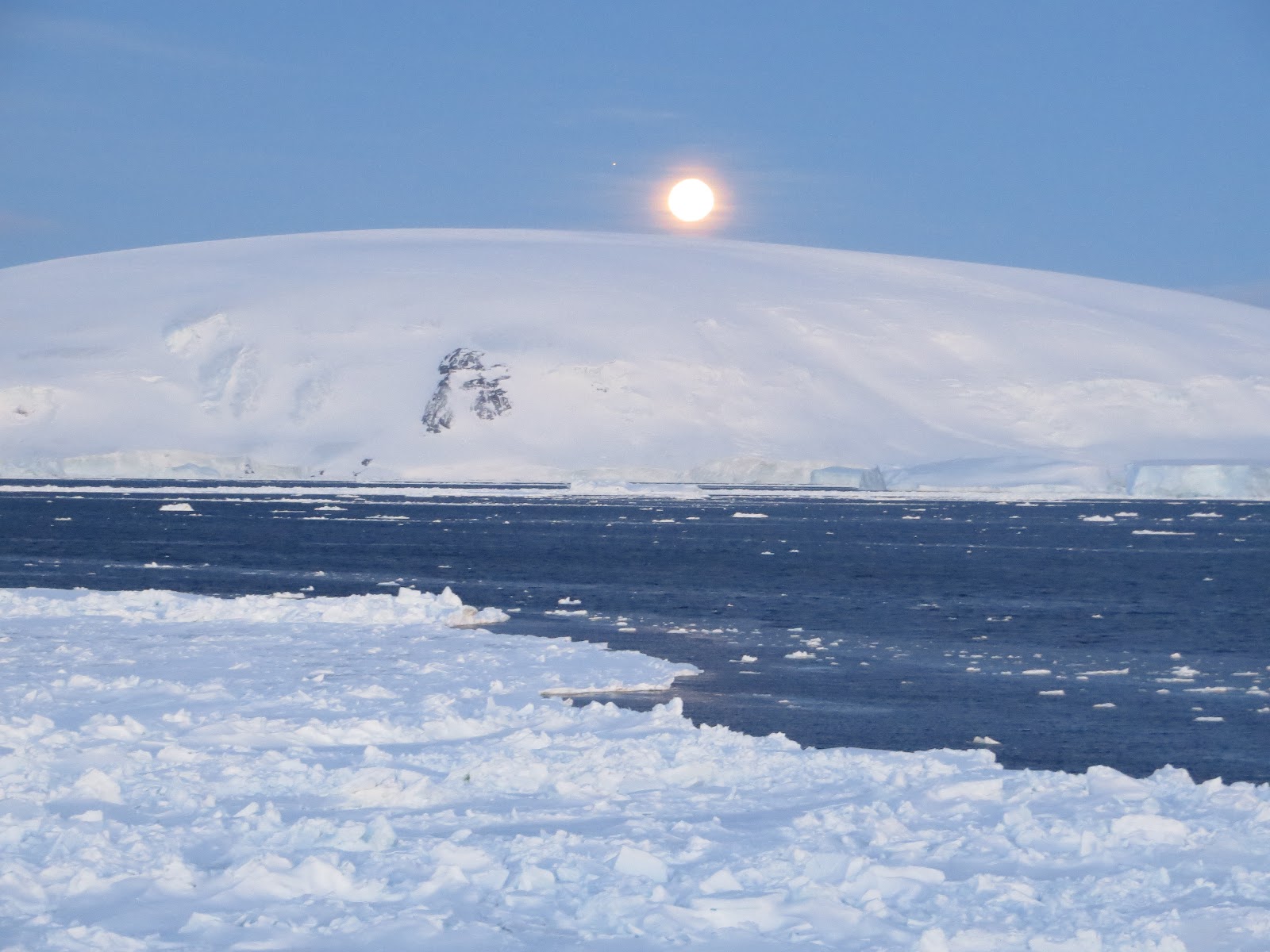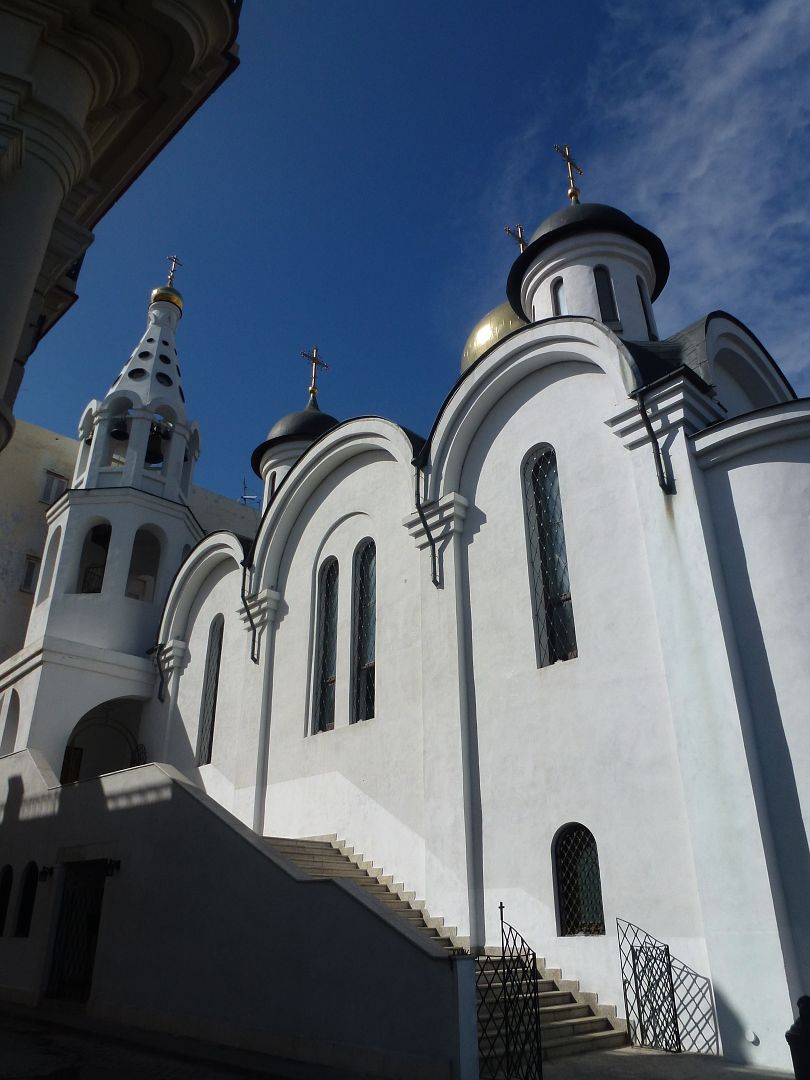 Due to our late start into the Drake, and the slower crossing to avoid the worst of the waves, we only passed through the South Shetland Islands half way through the day we had expected to be our first full day of landings in Antarctica. But here the seas calmed and we started to see some of the passengers that we 'lost' during the crossing.
Due to our late start into the Drake, and the slower crossing to avoid the worst of the waves, we only passed through the South Shetland Islands half way through the day we had expected to be our first full day of landings in Antarctica. But here the seas calmed and we started to see some of the passengers that we 'lost' during the crossing. With fine weather and only a gentle sailing motion, we took the opportunity to do a practice with the helicopters. It seems a strange thing to do, but it is very hard to hear what is being said once the helicopter is going, and people do get hit by turning rotor blades, because they can't see them. And that is in good conditions. Mind you, I think that part of the reason is just to give us something else to do and get us anticipating the landings.
With fine weather and only a gentle sailing motion, we took the opportunity to do a practice with the helicopters. It seems a strange thing to do, but it is very hard to hear what is being said once the helicopter is going, and people do get hit by turning rotor blades, because they can't see them. And that is in good conditions. Mind you, I think that part of the reason is just to give us something else to do and get us anticipating the landings. And we hit the ice - though not in the Titanic sense I am pleased to say. We spent some hours pushing our way through the loose ice floes and up on the bridge, I could hear that the captain was getting concerned about how much ice we would find if ahead we were hitting it already. We carried on through, watching the beautiful scenery around us, and wondering how far we would get.
And we hit the ice - though not in the Titanic sense I am pleased to say. We spent some hours pushing our way through the loose ice floes and up on the bridge, I could hear that the captain was getting concerned about how much ice we would find if ahead we were hitting it already. We carried on through, watching the beautiful scenery around us, and wondering how far we would get. It is hard to appreciate just how immense Antarctica is. We are only on the tip of the peninsula, but on a continent that is twice the size of Australia, and when the peninsula is around 1500km long, that makes for a pretty big 'tip'.
It is hard to appreciate just how immense Antarctica is. We are only on the tip of the peninsula, but on a continent that is twice the size of Australia, and when the peninsula is around 1500km long, that makes for a pretty big 'tip'. After all, it had just taken us nearly three days to sail here and that was only 1000km. And all we could see stretched ahead of ice was miles and miles of sea ice and ice bergs. With a few seals and penguins thrown in of course.
After all, it had just taken us nearly three days to sail here and that was only 1000km. And all we could see stretched ahead of ice was miles and miles of sea ice and ice bergs. With a few seals and penguins thrown in of course. When we were here last, we saw some impressive icebergs, but this is where the really big ice lives. The tabular icebergs are freshwater ice that breaks off the vast ice shelves and floats away. Many of the really big ones that we saw were some miles in the distance, locked into the sea ice.
When we were here last, we saw some impressive icebergs, but this is where the really big ice lives. The tabular icebergs are freshwater ice that breaks off the vast ice shelves and floats away. Many of the really big ones that we saw were some miles in the distance, locked into the sea ice. But if you consider that the above water section of our ship Ortelius is about 18m high excluding the masts, then that may help with a perspective in some photos. Bear in mind that a typical height can be 75m, and then you can see from their shape that this makes them very long and wide. Of course 75m is only the visible part; there will easily be seven or eight times as much underneath.
But if you consider that the above water section of our ship Ortelius is about 18m high excluding the masts, then that may help with a perspective in some photos. Bear in mind that a typical height can be 75m, and then you can see from their shape that this makes them very long and wide. Of course 75m is only the visible part; there will easily be seven or eight times as much underneath. So during the daytime hours, we were looking out onto great swathes of white, with just a few hints of blue. As the sun set at around ten, we were treated to some beautiful reds, oranges and pinks. Then after that, because this far south in the summer it doesn't get fully dark, we still had a lovely hazy, blue tinged landscape to look at.
So during the daytime hours, we were looking out onto great swathes of white, with just a few hints of blue. As the sun set at around ten, we were treated to some beautiful reds, oranges and pinks. Then after that, because this far south in the summer it doesn't get fully dark, we still had a lovely hazy, blue tinged landscape to look at. At around 1am, with most passengers tucked up in bed, I was back up on the bridge watching our progress. The way these ships work is that they break the ice and push it away. That works all the while there is somewhere to push the ice to. But if the ice is solid for too large an expanse, then it has nowhere to go, so the ship can't get through. The ice we were at now was solid for miles ahead of us.
At around 1am, with most passengers tucked up in bed, I was back up on the bridge watching our progress. The way these ships work is that they break the ice and push it away. That works all the while there is somewhere to push the ice to. But if the ice is solid for too large an expanse, then it has nowhere to go, so the ship can't get through. The ice we were at now was solid for miles ahead of us.  The captain moved the ship into the ice, cracking it up and forcing it along and behind us, but he soon reached a point where the ice had nowhere to go to, and we were in real danger of being trapped in the ice. He had no choice but to pull back into the more open waters.
The captain moved the ship into the ice, cracking it up and forcing it along and behind us, but he soon reached a point where the ice had nowhere to go to, and we were in real danger of being trapped in the ice. He had no choice but to pull back into the more open waters. We were still a long way out from our destination of Snow Hill Island, and so those few of us that were up knew that our plan to see the emperor penguin rookery was already looking decidedly dodgy.
We were still a long way out from our destination of Snow Hill Island, and so those few of us that were up knew that our plan to see the emperor penguin rookery was already looking decidedly dodgy. In the morning, the expedition leader Delphine, the Captain and the helicopter crews spent some time discussing what options were open to us. They tried the ice again, but it was not going to be possible safely to get through.
In the morning, the expedition leader Delphine, the Captain and the helicopter crews spent some time discussing what options were open to us. They tried the ice again, but it was not going to be possible safely to get through.
The next step was a helicopter recce. This showed that while there were a few pockets of open water which the ship would be able to navigate through, there was no way through or around this large expanse we were already at.
 The emperor penguin rookery was expected to be on the sea ice on the other side of Snow Hill Island, which was over thirty miles away from our current position. This doesn't sound much but in Antarctica, where the weather can suddenly get very bad, very quickly, you just can't safely do a trip that far. There would be too much risk of getting stuck too far away from the ship.
The emperor penguin rookery was expected to be on the sea ice on the other side of Snow Hill Island, which was over thirty miles away from our current position. This doesn't sound much but in Antarctica, where the weather can suddenly get very bad, very quickly, you just can't safely do a trip that far. There would be too much risk of getting stuck too far away from the ship. So our visit to the rookery was not going to be possible, and this far out, we had no idea whether we would get to see any emperors at all. Clearly everyone was disappointed, especially a few people who had not realised that there was a genuine risk of not being able to get there, but we knew that the Captain and Delphine had not given up without an effort. And they were soon telling us about some great alternative plans.
So our visit to the rookery was not going to be possible, and this far out, we had no idea whether we would get to see any emperors at all. Clearly everyone was disappointed, especially a few people who had not realised that there was a genuine risk of not being able to get there, but we knew that the Captain and Delphine had not given up without an effort. And they were soon telling us about some great alternative plans.
In the meantime, what we did have a lot of though, was the ice. Our purpose in coming to the Weddell Sea was the emperors and the big ice. We may not have been getting to the rookery, but we were certainly seeing the ice.
As with many occasions, our photos simply cannot capture the real beauty and magnificence, or the sheer size, of the real thing, but I hope that they at least give you an idea of just what an amazing place this is.






































